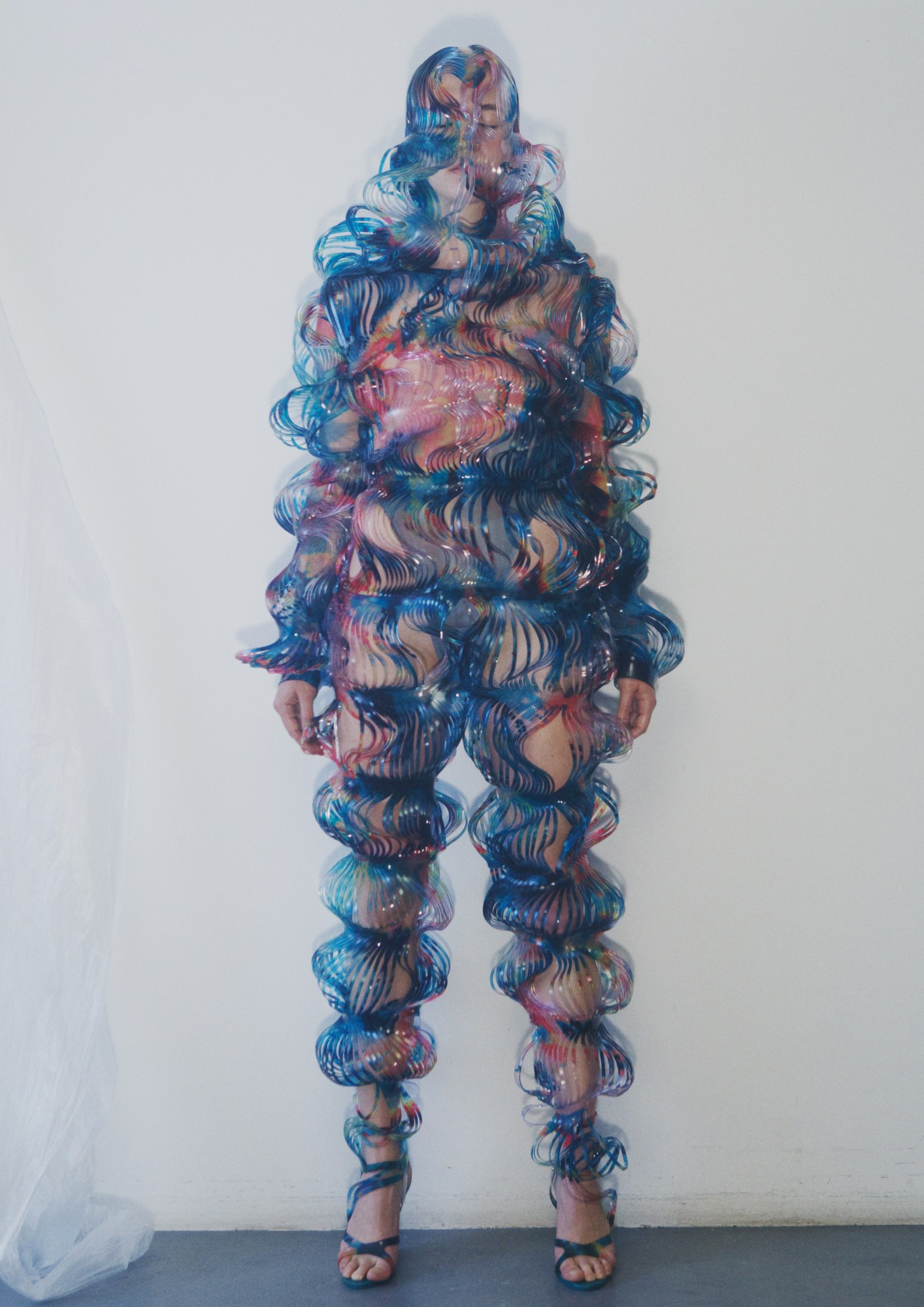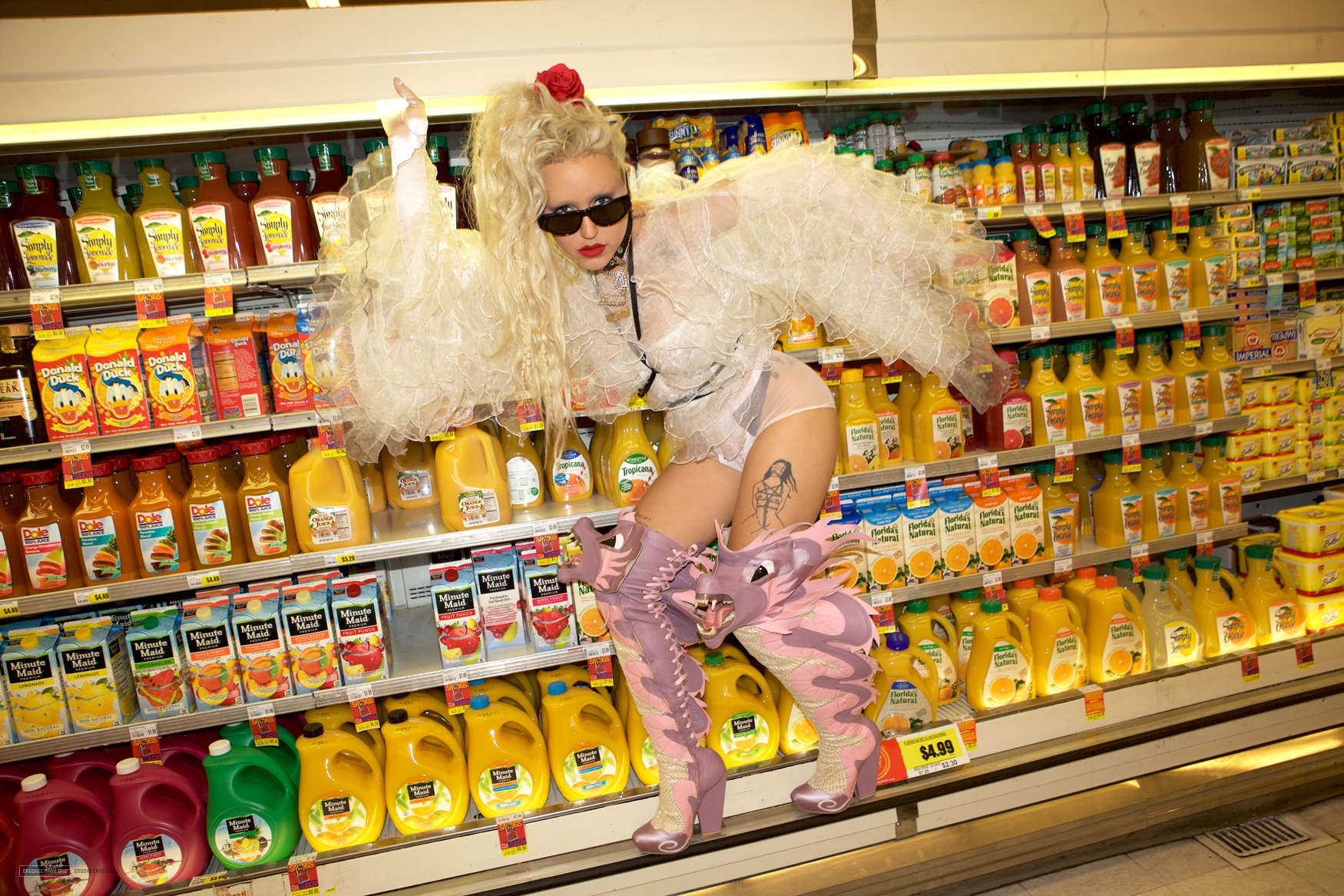People don’t generally think of “feminist footwear” as towering stiletto heels. Unless, perhaps, they’re adorned with sculptural hand-embroidered vulvas, each finished with a shiny clitoris pearl. Kira Goodey’s empowering pussy shoes — made in collaboration with Namilia for the Berlin-based brand’s spring/summer 18 collection — were a commentary on the false dichotomy of bra-burning feminist and straight-laced housewife. “You see dicks everywhere, but there’s still so much taboo with the vagina,” Kira tells i-D. “I really wanted to show it in all its beauty and celebrate these two archetypes of womanhood — the virgin versus the whore, the princess versus the pornstar — and to show that as women we are both of these things and so many other things.”
In a world where grimy dad sneakers and actual orthopedic shoes are runway mainstays, the London-based designer’s bespoke footwear feels even more subversively sexy. Kira’s recent creations include literal cage shoes and holographic peplum platforms, for two fellow students from the Royal College of Art grad show. She collaborated with Australian designer Jamie Lee on an intense pair of dragon boots endorsed by Brooke Candy, and flowing ponytail pumps worn by Britney Spears. It’s a far cry from Western Australia, where Kira grew up before landing an internship under late legend Alexander McQueen.
As London Fashion Week wrapped up, Kira spoke to i-D about feminism and fantasy.

You interned at Alexander McQueen after moving from Australia to London.
It was a weird time. It was his last year before he died. I left literally two weeks before he passed away. I went back a few weeks later to pick up my reference letter, and it was a very sad, weird time. But I felt so lucky that I got to work under him.
What was the experience like while you were there?
It was amazing, but very eye-opening in terms of how much work there is involved in this industry. People in fashion work so hard. It’s ridiculous. It was very challenging, but completely inspiring and mesmerizing. Equal parts hard and amazing.
Most people associate Western Australia with Uggs and flip-flops. What drew you to bespoke footwear?
I always had a real passion for craft. I’ve always made things, I’ve always worked with my hands. I got to a point in my career where I’d worked in womenswear, accessories, and all the various elements of clothing except shoes. Then I found this guy, sadly he’s closed his studio now, but he had this gorgeous studio and gave lessons in bespoke footwear. I was like, “This is one part of the process I haven’t tried.” It seemed like such a mystery. Where do you begin with shoes? I had absolutely no clue. It sounded really fun, and I wanted try it. I just got hooked.

You were speaking earlier about the stereotype of virgin vs whore. Is that false dichotomy something that runs through all of your work?
100%. I’m both drawn to these overly sexualized female archetypes, and at the same time, appalled by them. There’s a bizarre power that comes through footwear. As a woman, when I put on a pair of amazing heels, I feel this height, I feel like I tower above people, I feel like I have a presence. But at the same time, obviously, it’s something that’s painful and uncomfortable and makes life impractical. It’s tied to things that make people think of women as being less capable in the workforce. I’m definitely a feminist, but there’s so much complexity to it. I’m doing something that’s quite a male trade. Bespoke shoemaking is very much something that’s been all-male guilds for centuries. The fact that I’m doing this but then really fetishizing the female form — I know it’s a bit of a contradiction, but we all are contradictions.

What else inspires your work?
I’m really into cartoons, so there’s always a cartoony element to everything I do. One of the big draws for me moving to London was that I’ve always been really passionate about history. I love beautiful old buildings and old architecture. I go to a lot of galleries and a lot of stately homes and castles. I’m really inspired by the craftspeople of the past — people like Wedgwood, for instance, who were amazing social pioneers and amazing entrepreneurs, but also were the absolute best at their craft. Music also definitely drives what I do. But my primary inspiration would be materiality. I always find my process through playing with materials, and I like to let materials govern the forms that come out of it.
One of the most impressive things to me, about your work, is that all the shoes are actually wearable. You even collaborated with Adidas.
That was a while ago — I did a special project with Adidas Football. They got a few young designers from various disciplines to play around with the football boot. I don’t like football, I have no interest in football, so I had to come from a completely different angle and try to find something I could grasp that interested me. It was more like the space around football — showing the movement and the aerodynamics. It ended up being something completely non-functional, just decorative. I like the irony of that. A football boot is supposed to be about function, and I made something completely unwearable that just looked cool.
Where do you stand on fashion’s obsession with ugly-cool, orthopedic-looking shoes?
It’s not for me. I don’t want to disparage anyone’s craft, because I know there are a lot of amazing designers behind those pieces. But I’m in fashion for the fantasy. Normal life is a drag. The world is terrible, reality is awful. I want fashion that takes me somewhere far away, somewhere magical, where I feel glamor and excitement and escape. I’m in it for the fantasy, for sure.
